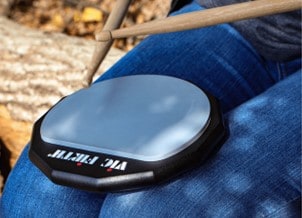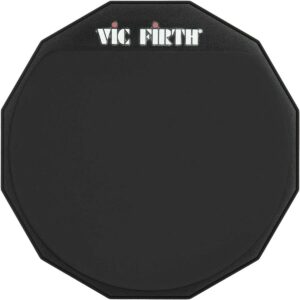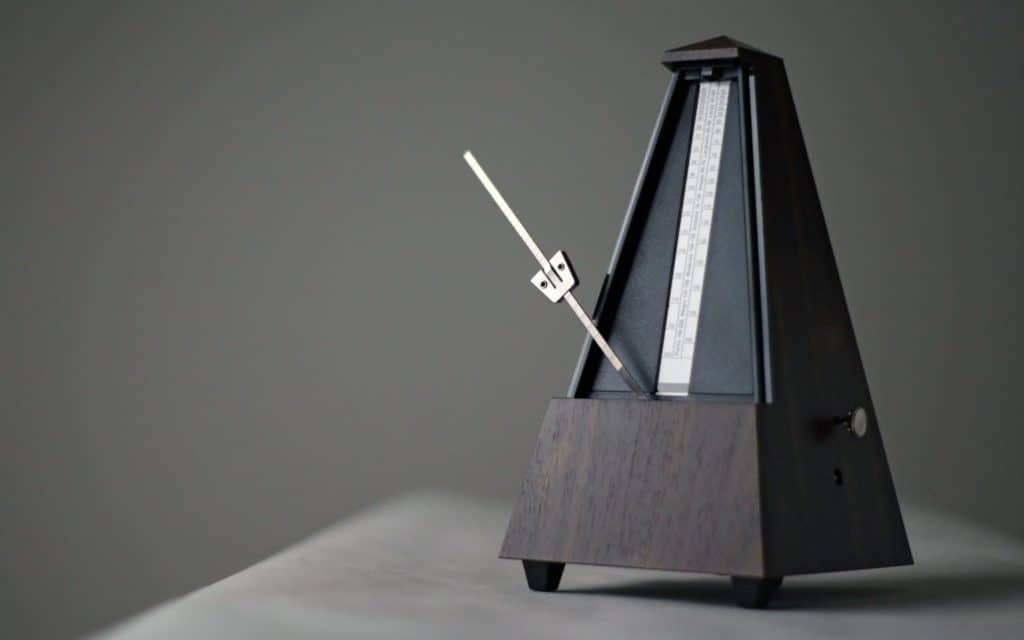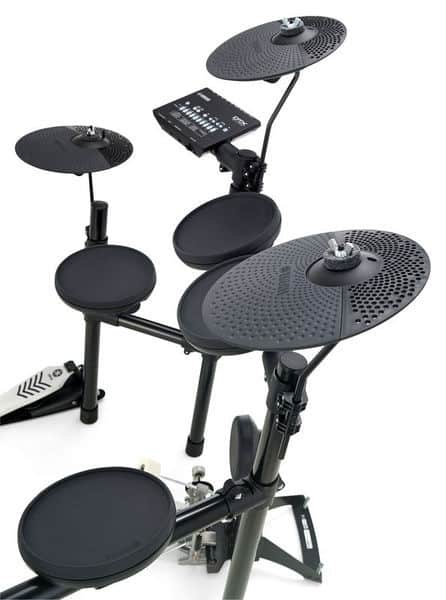Is it possible to learn to play drums without a drum set? Absolutely!
If you’ve always wanted to learn the drums, but don’t want to drive your neighbours crazy with a noisy drum kit, you’re in the right place.
I still use these tools for the vast majority of my practice as a professional drummer and teacher. It can be so helpful to avoid the noise, cost and hassle of acoustic drums!
Are you ready to jump in? Let’s begin!
How to learn to play drums without a drum set
- Get yourself a practice pad and a pair of sticks
- Find a mentor online or in person
- Practice your rudiments daily
- Further develop timing and independence
- Move onto an electronic drum kit
If there’s any section you’re particularly interested in, just click the links above!
Step 1: Get yourself a practice pad and a pair of sticks
If I’m not going to buy a drum set, then what will I be drumming on?
Every professional drummer I know has a high-quality practice pad. This is the foundation of good drumming and a perfect way to start to learn to play.
A practice pad is a thin, circular board that allows you to develop great technique, timing and muscle memory. You can take them anywhere, making them a favourite tool for many drummers. I always use one to warm up before a gig as well as in my daily practice.
One of my favourite drummer stories involving a practice pad is about legendary drummer Vinnie Colauita. Vinnie was always practising and would go through his whole day with sticks in hand.

The story goes that Vinnie could chat with his friends, practise on a pad, and eat noodles, all while keeping perfect time!
If you want to get good enough for noodle-level drumming, a practice pad is a perfect way to begin.
The advantages of a practice pad
- Much less expensive than a drum set.
- Light and portable.
- Develops a high level of muscular strength.
- Used by master drummers the world over.
- The fastest way to begin learning the drums.
- Considerably quieter than real drums (more neighbour friendly!)
Which practice pad should I get?
My favourite practice pad on the market – the one that I recommend to my students is this double sided 2-in-1 practice pad, made by a very well-known and respected drum company.
It has 2 different surfaces with different functions that improve your playing in different ways.

The softer grey surface is my favourite, it’s designed to be as realistic as possible to playing an actual drumhead which means that it will be much easier to take your drumming to an actual drum set afterwards.
Many of the other pads available don’t feel anything like actual drums, which means moving your playing to a drum set can be more frustrating.
I mostly use the softer surface myself so that I’m practising on a more realistic surface and find that practice on this pad translates well onto a range of drums.
The black surface is a harder, more responsive surface. It’s great for practicing valuable techniques that involve bounce, rudimental playing and marching band style drumming.

No matter the style of music you’re hoping to learn to play, getting comfortable with the bounce and having a great understanding of rudiments will level up your drumming massively.
I personally believe it’s better to invest in a high-quality pad than buy a cheap one as this will help you develop better strength, technique and control, allowing you to make the most of your practice.
I always recommend the 12 inch version of the pad, because you can rest it on your legs and keep it still more easily. Smaller versions are harder to balance and sometimes jump around on surfaces.
As some inspiration for getting started on a pad, check out this crazy video of Isiah Rowser showing off his skills!
These are exactly the kind of patterns (known as rudiments) that drummers learn on their practice pads, which they can then transfer to real drums, as Isiah Rowser is doing.
Which sticks should I get?
Once you’ve got yourself a great practice pad, you’re going need a pair of sticks. There are a wide variety of options available, but typically, you’re going to want to go for a 5A drumstick.
The 5A drumstick is the classic stick used by drummers from almost every genre of music.
It’s a medium weight stick suitable for most musical situations. Many of the great drummers of the past have relied on 5A sticks and you should too!

While there are a number of great drum stick brands, none is more iconic than Vic Firth. I always use Vic Firth 5A drum sticks thanks to their reliability and superior quality.
Like practice pads, sticks are not all equal. For example, Vic Firth sticks are pitch-paired to ensure that each drum stick produces the same sound when striking a drum or pad.
Step 2: Find a mentor online or in-person
So you’ve got your practice pad and sticks. But what should you be learning? What are the essential skills you need to be a great drummer?
Finding a mentor is the easiest way to learn everything that you need to know.
Having a teacher is the fastest way to speed up your learning curve, because they’ll help you focus on the things that really matter, and avoid the mistakes that can cost you years of wasted effort.
I’ve been teaching the drums for over a decade now, and it’s still so much fun to help a new student play their first song. In fact, we often play 2 or 3 famous songs in the first lesson – when you know what you should be learning, it’s easy to get started!
Most of my students don’t have drums when they start learning to play, so I design my lessons for students who don’t have access to a drum set.
If you’d like to feel confident playing to some cool songs and learn great technique from the very start, you’re welcome to drop by for a fun, friendly and free lesson with me soon. I teach online on Zoom, and you don’t need any equipment to get started!
You can click here if you’d like to find out more about my drum lessons.
Step 3: Practice your rudiments daily
There are many sets of patterns that drummers can learn to become more developed players. These patterns, called rudiments, can make up a significant portion of a drummer’s daily practice if they choose to focus on them.
The Percussive Arts Society has a list of 40 drum rudiments that they believe to be the most important to every student of drumming.
You’ll start with the simplest rudiment, single strokes, until you can play advanced and complex rhythms like ratamacues and flamadiddles.

If you want to see some rudiments in action on the drum set, check out this iconic drum track featuring John Bonham of Led Zeppelin. He’s using a wide range of rudiments here to create an incredible drum solo!
If you want to reach the level of a legendary drummer like John Bonham, it all starts on the pad. Get the basics right first by learning simple rudiments and then move on to our next step!
Step 4: Further develop timing and independence
Two skills that are critical for drummers are timing and independence. If you’ve been practising on the pad, you’ve already started work on these key skills.
Timing
Timing is the most important skill a drummer can possibly possess. The drummer is the rock at the centre of the band that keeps all the musicians playing together and in time.
Many people say that only talented musicians have great timing, but did you know that this is a skill that you can develop?
In my article ‘Is It Hard To Learn Drums’, I break apart some of the common myths and misconceptions around learning to play the drums.
Working on your timing is essential to developing as a drummer. Whilst playing rudiments or common drum beats, drummers often use metronomes to avoid speeding up or slowing down.

A metronome produces a series of clicks in perfect time to help musicians play evenly.
Next time you are practising on your pad, try playing along with an online metronome! It’s tricky at first, but once you get the hang of it, this will do wonders for your playing.
Independence
Are you wondering how Vinnie from our story earlier could eat his noodles whilst practicing on his pad?
It’s often said that drumming is like rubbing your belly while patting your head. In fact, there’s twice as much going on like that!
Drummers use all four limbs to play rhythms on the drum kit. This means they have to multitask, playing different rhythms with different limbs at the same time.
If this sounds impossible, don’t panic.
As you become a better and better drummer, your brain will develop so that you can multitask without even having to think about it.
The best way to start developing your independence is to play basic rhythms with your feet as you practice on your pad.
Start by playing a rudiment of your choice on your pad along to a metronome.
When you feel comfortable, see if you can tap your right foot on every beat whilst still playing the rudiment.
If you’re playing a rudiment with two hands, adding your right foot means you’ve already developed three-way co-ordination!
Then see if you can do the same with the left foot.
Finally, see if you can switch feet for every beat (playing your right foot on beats 1 and 3, and your left foot on beats 2 and 4).
This is the start of your journey to true drumming independence and being able to rock out on a full drum kit!
Step 5: Move onto an electronic drum kit
Once you’re starting to feel comfortable on the pad, you should definitely consider investing in an electronic drum set.
They are an incredible breakthrough for drummers who can’t practice with a full volume drum kit.
Put simply, electronic drum kits are a quiet way to experience the enjoyment of drumming.
Instead of striking drum skins, you play your musical ideas into electronic pads. Each pad represents a real drum or cymbal on a drum kit.
A computer in the electronic kit (known as a brain) records how hard you hit the pads and adjusts the sound you hear through your headphones accordingly.
The advantages of an electronic drum kit
- Allows you to develop four-way coordination.
- Resembles the shape of a real drum kit.
- Doesn’t upset the neighbours (may not be suitable for apartments/flats due to foot pedal vibration).
- A variety of sounds and different drum kits, depending on what style you want to play.
- Takes up less space than an acoustic drum kit.
I mentioned at the top of this article that I believed that practice pads and electronic drum kits can actually be a better way to begin to learn to play the drums than buying an acoustic kit.
There’s always a debate about whether electronic or acoustic kits are best, but in my opinion, both are perfectly valid ways to learn to play the drums. They both have their advantages and disadvantages. Many drummers I know use both!
One of the issues with acoustic drum kits is that it can be very difficult to listen to music and play them at the same time.
The music in your headphones needs to be very loud and without the right set up, you often don’t hear the subtleties of each song you are playing along to.
Now imagine that you’ve just got yourself a brand-new drum kit.
Wouldn’t it be much more enjoyable to be able to hear a metronome or the songs you are playing along to clearly?
Getting a perfect set up with an acoustic drum kit can sometimes be complicated. It often requires moulded in-ear plugs or high-quality, noise-cancelling headphones.
With an electronic drum kit, you can play at whatever volume you want.
I personally feel as a teacher that my students do a lot better when they are able to really listen deeply to the music they are playing. It seems a lot easier for them to work on crucial elements of drumming like timing and dynamics.
If you’re looking for a great beginner’s electronic drum kit, I’d personally recommend the Yamaha DTX432K, which is the latest version of the electronic kit I started out on.

It’s affordable, easy to learn on and has a wide range of high-quality drum sounds. Plus, it has some great practice modes like ‘rhythm gate’, where the drums only sound if you are playing in time.
Are you ready to start your drumming journey?
Thank you for reading this beginner’s guide for learning play the drums without a drum set.
I’d like to leave you with one of my favourite ever drumming videos that will hopefully inspire you to take up this amazing instrument.
The video linked below is a recording of Buddy Rich, widely considered to be the greatest drummer of all time.
Once you’ve checked out his astonishing drum solo (below), check out my teaching page if you’d like to have a free lesson and get started on your own drumming journey!
